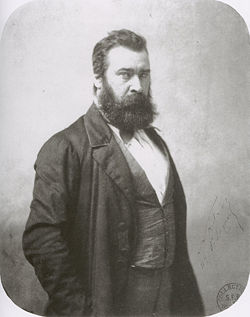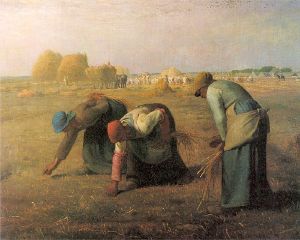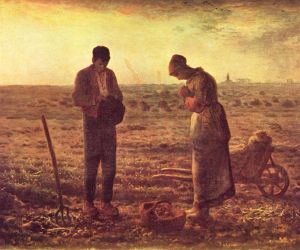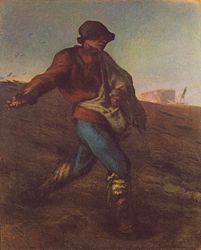Jean-Francois Millet
| Jean-François Millet | |
 Portrait of Millet by Nadar. Date unknown, 1850-1870 | |
| Birth name | Jean-François Millet |
| Born | October 4 1814 Gruchy, Gréville-Hague, Normandy |
| Died | January 20 1875 |
| Nationality | French |
| Field | Painting, Sculpting |
Jean-François Millet (October 4, 1814 – January 20, 1875) was a French painter and one of the founders of the Barbizon school in rural France. He is noted for his scenes of peasant farmers. He can be categorized as part of the movement termed "naturalism", but also as part of the movement of "realism".
Born in the village of Gruchy, in Gréville-Hague (Normandy), Millet moved to Paris in 1838. He received his academic schooling with Paul Dumouchel, and with Jérome Langlois in Cherbourg. After 1840 he turned away from the official painting style and came under the influence of Honoré Daumier. In 1849 he withdrew to Barbizon to apply himself to painting many, often poetic, peasant scenes.
The Gleaners
One of the most well known of Millet's paintings is The Gleaners (1857), depicting women stooping in the fields to glean the leftovers from the harvest, is a powerful and timeless statement about the working class. The Gleaners is on display in Paris's Musée d'Orsay.
Picking up what was left of the harvest was regarded as one of the lowest jobs in society. However, Millet offered these women as the heroic focus of the picture; previously, servants were depicted in paintings as subservient to a noble or king. Here, light illuminates the women's shoulders as they carry out their work. Behind them, the field that stretches into the distance is bathed in golden light, under a wide, magnificent sky. The forms of the three figures themselves, nearly silhouetted against the lighter field, show balance and harmony.
The Angelus
Commissioned by a wealthy American, Thomas G. Appleton, and completed during the summer of 1857, Millet added a steeple and changed the initial title of the work, Prayer for the Potato Crop to The Angelus when the purchaser failed to take possession in 1859. Displayed to the public for the first time in 1865, the painting changed hands several times, increasing only modestly in value, since some considered the artist's political sympathies suspect. Upon Millet's death a decade later, a bidding war between the US and France ensued, ending some years later with a price tag of 800,000 gold francs.
The disparity between the apparent value of the painting and the poor estate of Millet's surviving family was a major impetus in the invention of the droit de suite, intended to compensate artists or their heirs when works are resold.
The Angelus was reproduced frequently in the 19th and 20th centuries. Salvador Dalí was fascinated by this work, and wrote an analysis of it, The Tragic Myth of The Angelus of Millet. Rather than seeing it as a work of spiritual peace, Dalí believed it held messages of repressed sexual aggression. Dalí was also of the opinion that the two figures were praying over their buried child, rather than to the Angelus. Dalí was so insistent on this fact that eventually an X-ray was done of the canvas, confirming his suspicions: the painting contains a painted-over geometric shape strikingly similar to a coffin. (Néret, 2000) However, it is unclear whether Millet changed his mind on the meaning of the painting, or even if the shape actually is a coffin.
External links
- Maura Coughlin's article on Millet's Norman milkmaids
- Influence on Van Gogh
- Influence on Dali - grieving parents or praying peasants in The Angelus?
| Persondata | |
|---|---|
| NAME | Millet, Jean-François |
| ALTERNATIVE NAMES | Millet, Jean-François |
| SHORT DESCRIPTION | French painter and one of the founders of the Barbizon school |
| DATE OF BIRTH | October 4 1814 |
| PLACE OF BIRTH | Gruchy, Gréville-Hague, Normandy |
| DATE OF DEATH | January 20 1875 |
| PLACE OF DEATH | |
Credits
New World Encyclopedia writers and editors rewrote and completed the Wikipedia article in accordance with New World Encyclopedia standards. This article abides by terms of the Creative Commons CC-by-sa 3.0 License (CC-by-sa), which may be used and disseminated with proper attribution. Credit is due under the terms of this license that can reference both the New World Encyclopedia contributors and the selfless volunteer contributors of the Wikimedia Foundation. To cite this article click here for a list of acceptable citing formats.The history of earlier contributions by wikipedians is accessible to researchers here:
The history of this article since it was imported to New World Encyclopedia:
Note: Some restrictions may apply to use of individual images which are separately licensed.



